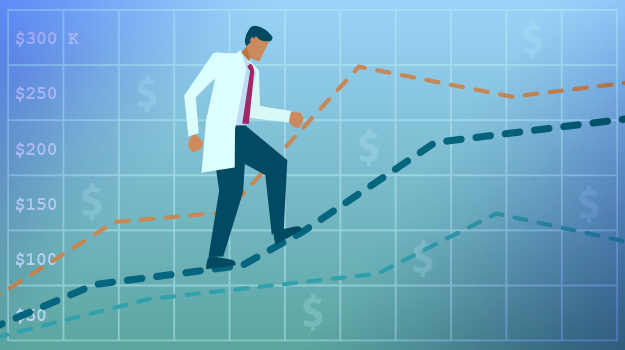Career resources content posted on NEJM CareerCenter is produced by freelance health care writers as an advertising service of NEJM Group, a division of the Massachusetts Medical Society and should not be construed as coming from, or representing the views of, the New England Journal of Medicine, NEJM Group, or the Massachusetts Medical Society
The annual Medscape physician compensation report delivered a mix of good news and not-so-good news. In the first category, despite the generally tumultuous economic and policy environment in health care this year, compensation is stable or increasing. Across all physicians, the average compensation is now $313,000 — solidly above $300,000 for the first time. Notably, primary care physicians (PCPs) continue to see substantial incremental annual gains: PCPs now earn $237,000 on average, Medscape reports, up 21.5 percent from the $195,000 average in 2015. Within the primary care specialties, gaps are lessening. Internists’ annual compensation averaged $234,000, family medicine physicians earned $231,000, and pediatricians $225,000.
The top flyers on the compensation chart include several specialties that have long been in the highest earners, along with a few newcomers. Orthopedics took the first spot, at $482,000, followed by plastic surgery at $471,000 and otolaryngology at $461,000. Cardiology took the fourth spot at $430,000, and dermatology and radiology shared the fifth, at $419,000. The only other specialties whose average income exceeded $400,000 were gastroenterology at $417,000 and urology at $408,000. Others in the top earners’ ranks include anesthesiology ($392,000), ophthalmology ($366,000), and general surgery ($362,000). Emergency medicine physicians’ average compensation was $359,000 and critical care physicians earned $353,000.
Public health and preventive medicine was the lowest-earning specialty, at $209,000, substantially below pediatrics, which had the second lowest compensation.
Gender gap — still a big issue
For female physicians awaiting the closing of the longstanding pay disparity between men and women in medicine, the news from the Medscape report, which surveyed 19,328 physicians in more than 30 specialties, is not good. Across the spectrum, male physicians earned 25 percent more than their female counterparts, a marked downturn from last year’s survey, which found an 18 percent difference; the gap was 16 percent in 2017 and 17 percent in 2016. For all survey years, the figures include only physicians who work full time. In this year’s sample, 64 percent of respondents were men and 34 percent were women.
Not surprisingly, the pay gap is more pronounced in the specialties. Average compensation for male specialists was $372,000, compared to $280,000 for female specialists — a 33 percent difference. One factor contributing to the overall pay disparity is that more women than men tend to choose lower-paying specialties. For example, women make up less than one-fifth of the following specialties: plastic surgery, orthopedics, cardiology, and urology. That reality, however, doesn’t alter the fact that the gender pay gap remains pronounced within those specialists — and all specialties.
The Medscape report also found compensation disparities among ethnicities. Overall, Caucasian physicians (who accounted for 75 percent of all specialist respondents) had an average income of $319,000 across all specialties, and mixed-race physicians earned $303,000. Average compensation for Hispanic/Latino physicians was $303,000. Average compensation was $300,000 for Asian physicians and $281,000 for African American/Black physicians.
Employment model affects earnings
Despite the continued trend toward physician employment by hospitals and health systems and the decline in doctors choosing private group practice or solo employment, self-employed physicians still outstrip their employed counterparts in the earnings department. The Medscape report cited average compensation of $359,000 for self-employed physicians, compared to $289,000 for employed physicians. Notably, 64 percent of self-employed physicians are over age 50.
There is some indication that young physicians in training or just out of residency are becoming more open to considering models other than straight employment. In last year’s Medscape Residents Salary & Debt Report, although only 20 percent of respondents expressed interest in practice ownership, 21 percent said that they might consider the option at some point.
Geography matters — a lot
There are numerous factors that affect how much physicians earn in different regions of the country. Those range from local payer mix, to physician supply and demand, and from the state malpractice environment to the prevalence of manage care. Overall, however, the Medscape compensation report found that physicians who practice in regions that lie between the two historically desirable East and West Coasts of the country tend to out-earn their counterparts in the states with the most popular urban areas, such as San Francisco, Seattle, New York, and Boston.
The following are the top five top states for physician compensation, along with average earnings:
1. Oklahoma — $337,000
2. Alabama — $330,000
3. Nevada — $329,000
4. Arkansas — $326,00
5. Florida — $325,000
Others in the top 10 include Kentucky at $324,000, Tennessee and Connecticut at $323,000, and Georgia and Indiana at $322,000.
Compensation and practice satisfaction, by the numbers
Although compensation has always been an important factor in how satisfied physicians feel with their practice lives, it’s not the only key determinant, based on numerous surveys’ results in recent years. This year’s Medscape survey findings illustrate how that disconnect plays out sometimes: the specialties most satisfied with their earnings were not necessarily those with the highest compensation.
For example, even though orthopedic surgeons out-earned all other specialties, only 52 percent reported being satisfied with their compensation. Similarly, only 52 percent of plastic surgeons and 49 percent of urologists consider their compensation satisfactory. Both infectious disease physicians and endocrinologists were in the low-satisfaction group, with only 42 percent feeling adequately compensated for their work.
The specialists who reported the highest satisfaction with their compensation included the following: public health and preventive medicine (73 percent), emergency medicine (68 percent), dermatology and radiology (66 percent), psychiatry (64 percent), and critical care (61 percent).
Medscape also asked physicians to rate how they view their own performance. To the extent that respondents answered honestly, 42 percent claimed that they’re very satisfied with their performance and 49 percent said that they’re satisfied. Only 2 percent were dissatisfied.
On the plus side, the majority of physicians reported that if they had the chance to start over again, they’d choose medicine. More than 80 percent of respondents in the following fields are satisfied with their career choice: infectious diseases, cardiology, nephrology, dermatology, ophthalmology, orthopedics, oncology, general surgery, critical care, and psychiatry.
Similarly, most physicians reported that they would choose the same specialty given the chance. Overwhelmingly (more than 90 percent) of ophthalmologists, orthopedic surgeons, dermatologists, gastroenterologists, urologists, and radiologists would choose their specialty again. However, about one-third of internists and family medicine physicians said that they would choose a different specialty.
Payment models shifting
As physicians and their employing entities are increasingly on the hook for measuring and reporting both quality and care-cost-associated financial performance, it stands to reason that payment models are shifting. In the 2019 Medscape survey, 28 percent of physicians reported accountable care organization (ACO) participation, up from only 3 percent in 2011 but down significantly from 36 percent in 2017. It’s worth noting that the number of ACOs increased from 480 in 2017 to 561 in 2018, according to national data. At the same time, Medscape survey respondents are reporting increasing concerns about ACO programs’ designs and risks, which might explain the recent participation drop.
The health care economists who predicted a decade ago that we’d see the end of fee-for-service medicine before this decade is out are being proved wrong. Medscape reports that 44 percent of physicians are still involved in fee-for-service payment models. In terms of alternative payment models, only 11 percent of respondents reported involvement in direct primary care (membership-fee care models), only 6 percent in cash-only practices, and a mere 2 percent in the concierge medicine practices that were once expected to take hold more broadly.
What is taking hold, however, is the Merit-Based Incentive Payment System, called MIPS. Forty-two percent of PCPs and 37 percent of specialists are either participating in MIPS or planning to do so soon.







